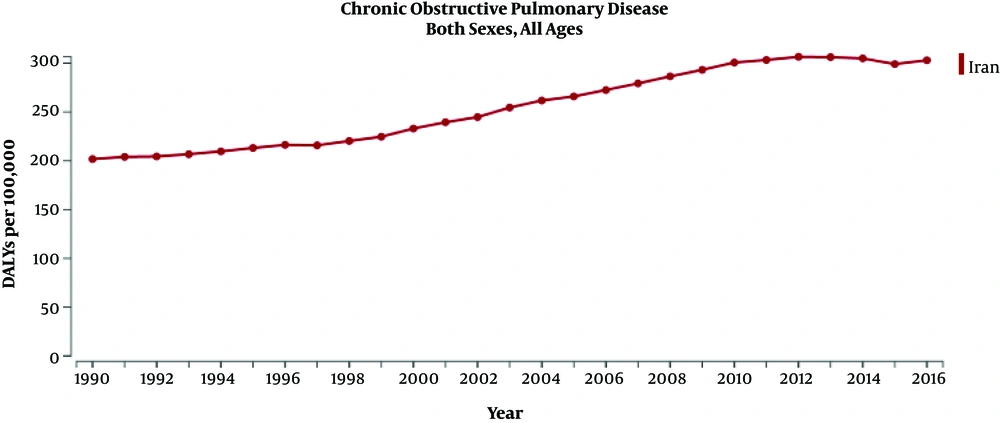1. Background
Chronic obstructive pulmonary disease (COPD) is an important public health challenge and a major cause of chronic morbidity and mortality throughout the world (1). Based on the data published by the Institute for Health Metrics and Evaluation (IHME), more than 3.58 million of deaths were due to asthma and COPD all over the world in 2015 (2).
Globally, the COPD burden is projected to increase in terms of the number of disability-adjusted life years (DALYs) in the coming decades due to the continued exposure of populations to COPD risk factors (smoking and air pollution) and the increased exposure in a number of countries (3); as a result, COPD is the fourth leading cause of death in the world. COPD is estimated to become the third leading cause of death in the world by 2020, which is an alarming news (1). COPD is generally considered to be more prevalent in men than in women (4). Smoking is a growing habit in women in developing and developed countries, and exposure to biomass fuel for domestic purposes is also a recognized risk factor of COPD among women. As a matter of fact, women often develop more severe COPD compared to men if they are ever exposed to tobacco, which could be due to a genetic predisposition (4).
In Iran, a study by Varmaghani et al. showed that the mortality rate attributable to COPD has risen during the past 15 years. This rate might have increased due to the increased exposure of people to COPD-related risk factors, such as air pollution, which is a common problem in larger cities (5). In its Global Burden of Disease (GBD) study, the IHME collected all the available data from all countries and regions and analyzed them systematically in order to produce the best possible evidence on the burden of diseases and their risk factors.
2. Objectives
This report examines the burden of COPD and its risk factors in the Iranian population.
3. Methods
The GBD study by the IHME offers rigorous and comparable data and evidence regarding the DALY attributed to each risk factor and disease by age, gender, year and location. The details of the methods used for calculating the DALY have already been published (6). The general and main objectives of the GBD study include the improvement of health in all world populations by providing the best information on public health using the available data. The IHME collects all the relevant data on the causes and risk factors of diseases, and after applying statistical methods, calculates the DALY attributed to each cause and risk factor. This information is freely available and policymakers can have the evidence they need to make informed decisions about how to allocate resources to best improve their people’s health. The present study used the information and results gathered through the IHME study on the DALYs of COPD and its risk factors using the GBD study in Iran in 2016 (2).
4. Results
Based on the IHME results, the rate of DALYs was 201.8 per 100 000 population (95% CI: 168.7 - 245.4 DALYs per 100 000 population) in 1999 and 303.1 per 100 000 population (95% CI: 261.6 - 347.8 DALYs per 100 000 population) in 2016 (Figure 1). The results showed that about 0.47% of the total estimated DALYs in Iran (1990) were related to COPD. This figure increased to 1.45% in 2016. The annual percentage of change (APC) for DALYs related to COPD was 1.56%. The share of COPD from DALYs increased from 38 in 1990 to 20 in 2016 in Iran, and the share was 16 for non-communicable diseases in 2016. This increase in DALYs can be attributed to the increase in the years of life lost (YLL) and the years lived with disability (YLD), both of which showed a sharp increase over the study period.
According to the GBD estimation, behavioral risks (i.e. tobacco) and environmental risks (i.e. air pollution and occupational hazards) were the main factors associated with COPD. The attributable risk of tobacco for COPD was 140.3 DALYs per 100 000, and air pollution and occupational hazards were responsible for 98.4 and 39.5 DALYs per 100 000. The trends in the attributable burden of COPD to tobacco showed a sharp increase from 1990 (69.64 DALYs per 100 000), which is also true about air pollution, as 61.09 per 100 000 of DALYs were attributed to this risk factor. These risk factors were more prevalent among men than women and more DALYs were attributed to them (Table 1). The percentage of COPD-related DALYs attributable to behavioral and environmental risk factors was 75.7% in 1990 and 91.6% in 2016 in Iran.
| Risk Factors | Male | Female | Total |
|---|---|---|---|
| Tobacco | 193.1 (130.2 - 262.5)a | 86.7 (43.5 - 128.1) | 140.3 (102.3 - 183.3) |
| Air pollution | 128.1 (80.7 - 180.2) | 68.2 (43 - 99.7) | 98.4 (63.4 - 136.4) |
| Occupation risks | 71 (54.9 - 91.3) | 7.61 (5.1 - 10.8) | 39.5 (30.1 - 50.2) |
Attributable DALYs (Per 100,000) for Risk Factors of COPD in Iran, 2016
5. Discussion
The total burden of COPD increased from 201.8 to 303.1 per 100 000 population during 1999 - 2016 and the APC for this increase was 1.56% in Iran. In line with the results of the GBD study, Varmaghani et al. (5) showed that the COPD-related mortality rate increased from 2001 to 2015 in Iran. Different factors affect these increasing trends in both mortalities and DALYs. First, similar to other developing countries, there was a decline in the first group of the causes of disease burden (communicable, nutritional and maternal diseases); plus, the population has aged in Iran over the last four decades. Both these items can increase the rate of death by other conditions such as COPD (7, 8). Second, the mortality and YLD related to tobacco and also the YLD related to air pollution increased over the period of the study. These two factors are the most important contributors of COPD.
The main risk factor of COPD was tobacco, followed by air pollution and occupational hazards, which were responsible for 140.3, 98.4 and 39.5 of DALYs per 100 000, respectively. Similar to most other countries, male predominance was the pattern for all the values related to the burden of COPD. While 1.45% of the total DALYs were related to COPD in 2016, this value shows a three-fold increase from 1990 (0.47%). Faced with long-term droughts and climate change, many countries such as Iran in the Middle East and north African countries will be suffering from drying wetlands (9). For these reasons, the number of dust storms is increasing and all such factors will increase the cases of COPD in the future.
The most important limitation of this study is that the results of the GBD study are based on estimates; however, since they use different data sources and statistical methods to estimate the burden of diseases, their results are close to reality.
The results showed that the burden of COPD is increasing in Iran and constitutes an alarming threat to public health. In fact, most of the risk factors for COPD are preventable. Health policymakers therefore need to have a holistic approach in order to decrease the burden of COPD in the future years. Policymakers can reduce the burden of this disease by intervening with behavioral risk factors such as tobacco and properly planning to reduce environmental risk factors.

